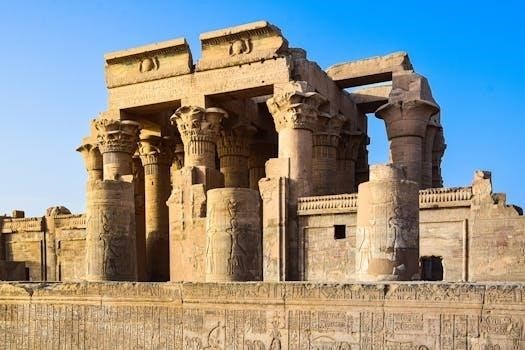Overview of Ancient Egyptian Deities
The ancient Egyptian pantheon was exceptionally complex, featuring over 2,000 deities. Each god and goddess possessed distinct names, personalities, and domains. These divine figures played crucial roles in Egyptian religious life and society.
The Complexity of the Egyptian Pantheon
The Egyptian pantheon’s complexity stemmed from the sheer number of deities, exceeding two thousand, each with unique names, personalities, and roles. These gods governed various aspects of life and the cosmos, from the sun’s daily journey to the underworld’s mysteries. The deities’ functions often overlapped, and their attributes evolved over time, reflecting the changing cultural and religious landscape of ancient Egypt. Moreover, local deities held significant importance, with individuals often identifying strongly with the main god or goddess of their nearest town. This intricate web of interconnected deities and evolving beliefs contributed significantly to the richness and enduring fascination with ancient Egyptian religion, making it a complex system to understand.
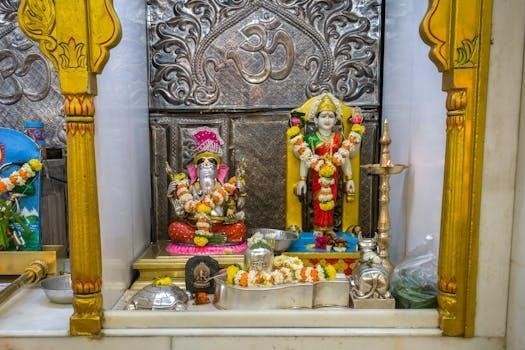
Key Gods and Goddesses
Several gods and goddesses held prominent positions within the Egyptian pantheon. These include Ra, Osiris, Isis, and Anubis, each associated with specific domains and significant roles in mythology and religious practice.
Ra⁚ The Sun God
Ra, the sun god, held a central position in the ancient Egyptian pantheon. He was often depicted with a falcon head and a sun disk atop his head. Ra’s daily journey across the sky in his solar boat was a fundamental aspect of Egyptian cosmology. Each night, he traversed the underworld, battling Apophis, the serpent of chaos, to ensure the sun’s return.
Ra’s importance extended to kingship, with pharaohs often associating themselves with him. He was considered the creator and source of all life, embodying light, warmth, and the cycle of renewal. Temples were dedicated to Ra throughout Egypt, and his worship remained prominent for centuries.
Osiris⁚ God of the Afterlife
Osiris, a pivotal figure in Egyptian mythology, reigned as the god of the afterlife, resurrection, and fertility. His story is central to Egyptian beliefs about death and the afterlife. Murdered by his brother Seth, Osiris was resurrected by his wife Isis, becoming the ruler of the underworld.
Osiris judged the souls of the deceased, determining their worthiness to enter the afterlife. He was often depicted as a mummified man, symbolizing his connection to death and rebirth. His association with agriculture and the Nile River further emphasized his role in renewal and sustenance. Osiris’s cult was widespread, promising eternal life to those who followed his teachings.
Isis⁚ The Mother Goddess
Isis, revered as the quintessential mother goddess in ancient Egypt, embodied protection, magic, and healing. She was the devoted wife of Osiris and mother of Horus, playing a crucial role in their stories. Isis’s magical abilities were legendary, notably her resurrection of Osiris, demonstrating her power over life and death.
She was often depicted with wings, symbolizing her protective nature, and with the tyet symbol, representing life and well-being. Isis was worshipped throughout Egypt and beyond, with temples dedicated to her in various locations. Her influence extended to Roman culture, where she was also venerated as a powerful and benevolent deity;
Anubis⁚ God of Mummification
Anubis, easily recognized by his jackal head, held a prominent position in ancient Egyptian beliefs as the god of mummification and the afterlife. His primary duty was to oversee the embalming process, ensuring the proper preservation of the deceased for their journey into the underworld. Anubis guided souls through the afterlife, weighing their hearts against the feather of Ma’at to determine their worthiness.
Representations of Anubis are found extensively in tombs and funerary texts, highlighting his crucial role in the transition from life to death. He was also associated with protection, guarding tombs from intruders and evil spirits. Anubis was revered as a powerful and essential deity in ensuring a successful afterlife.
Amun and Amun-Ra
Amun, a significant deity, was one of the eight ancient Egyptian gods; He was often combined with Ra, becoming Amun-Ra, a powerful solar deity. He was even referred to as the King of the Gods.
The Evolution and Significance of Amun
Amun’s journey from a local Theban deity to a prominent figure in the Egyptian pantheon highlights the evolving nature of religious beliefs. Initially, Amun was part of the Ogdoad of Hermopolis. His consort was Ament Amun and Mut. Over time, he merged with Ra, the sun god, creating the composite deity Amun-Ra.
This fusion significantly elevated Amun’s status, leading to his designation as the “King of the Gods.” The rise of Amun-Ra reflects the syncretism characteristic of ancient Egyptian religion, where deities merged and assimilated aspects of one another. This evolution demonstrates the dynamic interplay between religious beliefs and political power, as Amun’s prominence grew alongside the rise of Thebes. His story showcases the adaptable nature of ancient Egyptian religious thought.
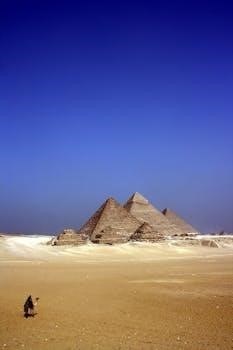
Deities and Their Symbols
Egyptian gods were often associated with specific symbols. These symbols represented their powers, roles, or origins. Understanding these symbols offers insights into the nature and function of each deity.
Matching Gods with Their Symbols
Ancient Egyptian deities were intrinsically linked to specific symbols that visually represented their powers, domains, and roles within the complex pantheon. Osiris, the god of the afterlife, is often depicted as a mummified man, signifying resurrection and eternal life. Ra, the sun god, is symbolized by the sun disk, embodying his daily journey across the sky and his role as a life-giver;
Anubis, the god of mummification, is associated with the jackal, reflecting his role in guiding souls through the afterlife and protecting the deceased. Hathor, the mother goddess, is represented by the cow, symbolizing her nurturing and maternal qualities. These symbols provide valuable insights into understanding the multifaceted nature of each deity and their significance in Egyptian religion and culture. The consistent association of gods with these symbols reinforces their identity and purpose within the religious framework.
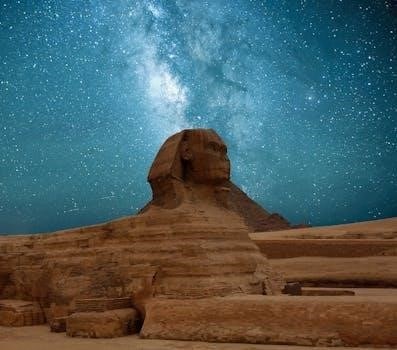
The Ogdoad of Hermopolis
The Ogdoad of Hermopolis consisted of eight ancient Egyptian gods. Amun was one of these deities and was a very powerful god. His consort included Ament Amun and Mut in mythology.
The Eight Ancient Egyptian Gods
The Ogdoad, originating from Hermopolis, represents a fundamental concept in ancient Egyptian cosmology. This group comprised eight primordial deities, existing before creation. They embody the chaotic, unformed state from which the world emerged. These gods and goddesses, in balanced pairs of male and female entities, symbolize the essential elements of this pre-creation state.
The male deities are typically depicted as frogs, while their female counterparts are represented as snakes. Their names reflect the abstract qualities they embody, such as darkness, obscurity, and formlessness. Through their interaction, they initiated the process of creation, eventually leading to the birth of the sun god and the ordering of the cosmos. They highlight the Egyptian understanding of the universe’s origins.
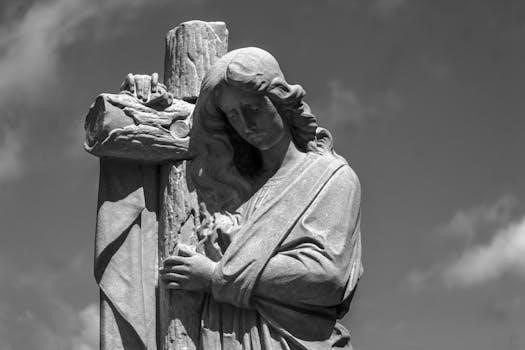
Religious Beliefs and Changes
Ancient Egyptian religious beliefs evolved significantly throughout history. The roles and importance of deities shifted over time, reflecting cultural and political changes. This dynamic nature shaped the complex pantheon.
Evolution of Deities and Roles Over Time
Religious beliefs in Ancient Egypt were not static; they underwent constant evolution. Gods and goddesses often assumed new aspects, merged with others, or experienced shifts in their perceived importance. This transformation reflected the changing cultural, political, and social landscapes of Egypt. The prominence of certain deities would rise or fall depending on the ruling dynasty or dominant religious ideologies.
For instance, Amun’s rise to prominence, culminating in his fusion with Ra as Amun-Ra, illustrates this dynamic. Furthermore, local deities could gain widespread recognition, integrating into the broader Egyptian pantheon. Understanding this evolution is crucial to grasping the nuances of Egyptian religious practices and beliefs over millennia, as well as the stories of the gods and goddesses.
